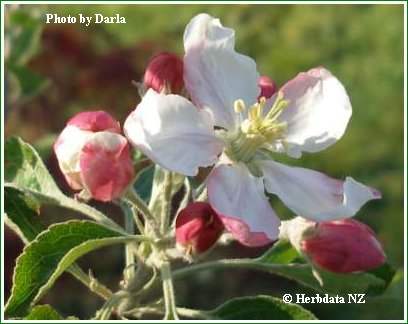
 PYRUS
MALUS. L. United States Dispensatory 1926.
PYRUS
MALUS. L. United States Dispensatory 1926.
Compiled by Ivor Hughes.
SUCCUS POMORUM. N. F. FRESH APPLE JUICE Suc. Pomor.
The freshly expressed juice of sound, ripe, sour apples, the fruit of cultivated varieties of Pyrus Malus Linne (Fam. Rosacece)." N, F.
The apple tree (Pyrus Malus L., Malus com-munis DC., Malus Malus (L.) Br.) probably originated in Europe and western temperate Asia, but has been cultivated from the most ancient times in all civilized parts of the temperate zone; it is even stated to have been grown in ancient Switzerland in the time of the lake dwellers.
It is a small tree rarely exceeding 30 or 40 feet in height with crooked spreading branches and a dark brown rough bark. It is prone to hybridize with related species and it is probable that some of the cultivated varieties are the results of crosses with other species.
The flower is white or sometimes tinged with pink, with a faint but pleasant fragrance. The fruit is a large pome which varies greatly in size, color and flavor as the result of cultivation. For medicinal purposes those varieties should be chosen which are rather firm in texture and sour in taste. The Siberian crab-apple, P. prunifolia Willd., is also cultivated. Its fruit is smaller and more acid than the ordinary apple. The American or wild crab apple, P. coronaria L., is also cultivated to a small extent. The expressed juice, commonly called cider, is a clear pale yellow liquid with a pleasant acidulous aromatic flavor. It must be obtained at the time that the cider is pressed and from reliable sources or an article preserved with sodium benzoate will be furnished by the grocer who sells large quantities of cider thus treated, for some cases cider has been entirely sophisticated by means of artificial flavoring and sweetening materials.
The fruit is approximately 85 per cent, of water, contains considerable amounts of sugar (7 to 8 per cent.) mostly fructose, a small amount of nitrogenous matter and a peculiar acid called malic, usually about a little less than 1 per cent. Pure malic acid (oxysuccinic), C4H6O5, occurs as colorless crystals soluble in water and with a rather pleasant sour taste melting at 100� C. The characteristic flavor of the apple is chiefly due to amyl valerate. The bark of the apple tree contains besides quercetin, the glucoside phlorizin (see Part II).
Uses.� The bark of the apple tree was at one time used as a tonic
and also as an anti-periodic, but is probably of no therapeutic
importance. The juice of the fruit or cider affords a pleasant acidulous
drink and is slightly laxative.
It is official for the purpose of preparing ferric malate which is the
active ingredient of the ferrated extract of apples. Iron malate occurs in
the form of brown hygroscopic scales soluble in either alcohol or
water.
Off. Prep: Extraction Ferri Pomatum, N, F.
Editors note : The old folk saying, "An Apple a day keeps keeps the Doctor at bay" is most certainly borne out by the nutrients and trace elements that it contains. The USDA have produced a list. A small 16kb PDF file may be downloaded Here ..
The offical N.F.prep may be sighted from the National Formulary as published in the site library.
If you did not find what you were seeking then use the site search box at the top right hand of the page or else peruse the site library.
![]()